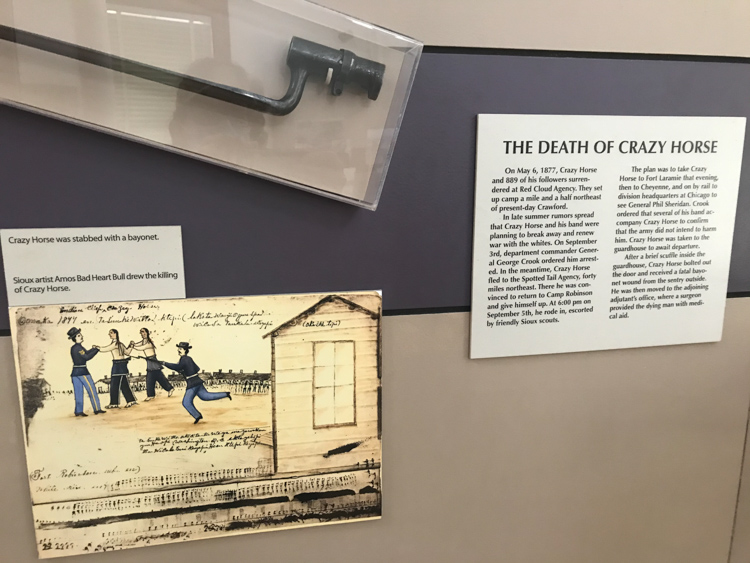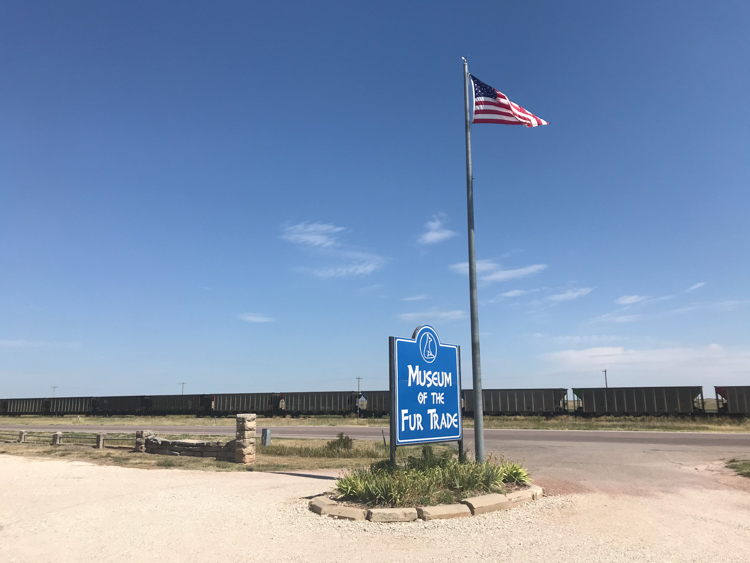Last year, we followed key historical events of the Civil War on our travels through South Carolina, Pennsylvania, and Mississippi. This year, we followed the Indian Wars during our travels through South Dakota, Nebraska, Kansas, Arkansas and Alabama.

Standing outside the RV on a hot and windy July evening, the eerie whistling of the stiff winds through the trees sparked my imagination of a wintery cold night as anything could. I gazed upon a Nebraska great plains scene from our Fort Robinson State Park campsite and thought about the feeling of freezing temperatures whipped up by the wind, knowing how it can cut you to the bone like a steely knife. I thought about that after visiting the Fort Robinson Museum and learning about the massacre that took place on these grounds in the winter of 1879. Contributing to my dark feelings were the comments from a park employee concerning the common sound of the wind through the trees that are thought to be spirits crying in the night.

What spirits? On March 29, 1874, Camp Robinson was established as a military post within the U.S. Red Cloud Indian Agency, a parcel of land designated for the resettlement of 13,000 Lakota Indians. The agency was created from the Fort Laramie Treaty of 1868 as were many other agencies or precursors to Indian Reservations. Camp Robinson was set up to protect the Agency and became the location of Crazy Horse’s murder, and soon after a massacre of Cheyenne Indians.


Following the battle of the Little Bighorn, the U.S. Government ramped up its war on the Native Americans. After suffering several defeats, the Indians began to drift into the agencies and surrender. Crazy Horse himself, the victor of Little Bighorn was convinced to return to Camp Robinson and give himself up. On September 5, he was taken to the guardhouse where something happened that caused him to bolt out the door. In a split second he received a fatal bayonet wound from a sentry guard. Hours later, Crazy Horse died from his wound on September 5, 1877.

Approximately one year and four months later, a band of captured Cheyenne led by Dull Knife broke out of Camp Robinson where they had been starved of food, water, and wood for heat as an attempt by the U.S. military to force the Indians into submission. The goal of the military was to make the Cheyenne return to Indian Territory in Oklahoma where the band had fled earlier in attempt to return to their land north of Nebraska. The consequence of Dull Knife’s group of about 150 men, women and children breakout was the massacre of all but 60 of the escapees who were captured and returned to Camp Robinson on January 22, 1879.

While camped at Fort Robinson State Park, the horrors of those days can be easily forgotten on the park’s friendly grounds where visitors can leisurely bicycle or walk around while taking in the historical sites. Horse back riding is a common activity here and one can enjoy a modest meal at the park’s lodge. In the days before Covid-19, hayride and chuckwagon cookouts were provided as entertainment. In the evening, Fort Robinson’s campgrounds are a familiar site with campers sitting comfortably outside their RV or tent, grilling and chilling. We had two days, so we assigned one day to immerse ourselves in Fort Robinson history and the second day to explore the surrounding area where we continued our Great Plains education.

Nebraska’s 200-mile Bridges to Buttes Scenic Byway (highway 20) bisects Fort Robinson State Park. It was along this highway that we explored the history of northwest Nebraska’s great plains beginning with the very small town of Crawford. It is one of hundreds we have seen during our travel; a once thriving rural community, now a skeleton of dilapidated buildings, some with a hint of life in them. We imagined growing up there and what might convince a young person to stay on past high school. The prospects look dim and from what I could tell Staab’s Drive-Inn (not a typo) is the only lucrative business that employs local teenagers. Crawford once thrived when the railroads reached Fort Robinson to bring in supplies to the soldiers. It became the entertainment center for the soldiers and fur traders, gaining quite a reputation as a wild frontier town as you can imagine. Oddly enough later in our travels and far away from Crawford, we met two RVers on two separate occasions who were born and raised in Crawford, NE, current population of 1116.

We continued driving east to the larger and more robust community of Chadron, home of Chadron State College. Chadron began as a fur trading post in 1841. Railroads led to its growth as did higher education that was brought to Northwest Nebraska in 1909 with the founding of Chadron State College. There we ate our packed lunch at a beautiful city park (Wilson Park) where a few others seemed to go to escape their office cubicles for an hour. Nearby was the college campus where we visited the Mari Sandoz High Plains Visitor Center.


The Mari Sandoz High Plains Visitor Center is more than that; it contains exhibits and is an active research facility containing ecological, geological and sociological collections relating to the great plains, with some art thrown in for show. An author of dozens of books, Sandoz was born and lived much of her life in the great plains, of which is the focus of her books. She wrote about Crazy Horse and the Sioux, she wrote about the fur traders, she wrote about the cattlemen, and she wrote about the buffalo hunters. Her detailed research makes each of her books an historical account of high plains life, especially relevant when coming from a woman who grew up there in a family of immigrant pioneers.


To round out our Great Plains education, we visited the Museum of Fur Trade, located a few miles east of Chadron. The museum is where over 6000 authentic artifacts are displayed to help tell the stories and history of the North American fur trade. Do not underestimate this distinctive attraction – it presents an interesting view of American history.

The trade industry was huge back in the day and the museum touts it as the first business in the New World. Fur trade was a significant means for Native Tribes to acquire many things, including firearms to resist the U.S. Government. There is so much going on here, that a quarterly journal is published through the museum. For the film “The Revenant” the producers relied on the Museum of Fur Trade for its authenticity.




Vivian and I never imagined the rich history that we would be exposed to during our visit to northwestern Nebraska. While planning, we basically lumped together our travels through Nebraska and Kansas into one segment – great plains states with a history but largely void of iconic national parks and archetypal landscapes and wildlife. To the contrary, both Nebraska and Kansas are full of surprises that transcend the prevailing flat farmlands. Stay tuned as we take you further into it, next time.
PS The title of this blog is a quote from Dave Barry’s Only Travel Guide You’ll Ever Need, 1991.
Our treatment of the Native Americans is heartrending. I didn’t realize Crazy Horse died up in Nebraska. We didn’t make it quite that far north. Another great read. Thanks for posting!
LikeLike